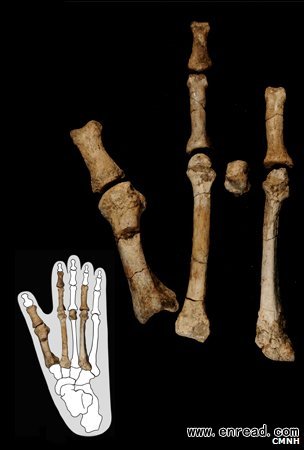| ||||||||||||||||||||||||||||||||||||||||||||||||||||||||||||||||||||||||||||||||||||||||
|
Scientists have obtained a fascinating new insight into the evolution of humans and our ability to walk. 科学家对于人类的进化以及直立行走的能力有了全新的认识。  The eight elements are all from the forefoot The researchers say they do not have enough remains1 to identify the species of hominin, or human ancestor, from which the right foot came. But they tell Nature journal that just the shape of the bones shows the creature could walk upright at times. The fossil haul consists of eight elements from the forefoot - bones such as metatarsals(跖骨) and phalanges(趾骨) . The specimens2 were pulled from clay sediments3 at Burtele in the central Afar region, about 520km north-east of the capital Addis Ababa. It is a significant discovery because it demonstrates there was more than one pre-human species living in East Africa between three and four million years ago, each with its own method of moving around. The other creature was the famous "Lucy" animal (Australopithecus afarensis), whose remains were first identified in the Afar in the 1970s. Lucy's body was built for walking. Her big toe was aligned4 with the other four digits5 of the foot, and she had a human-like arch that allowed for very efficient locomotion6. The owner of the partial foot from Burtele was not afarensis; that can be said definitively7. The fossils indicate it had no arch and the big toe was opposed to the other digits, enabling the animal to grasp branches in a tree. But the fact this creature could and would walk on the ground is evidenced by the nature of the bone joints9. These were arranged such that the foot could push off, or toe-off - something only humans do as they walk, and something flat-footed apes cannot achieve. "If you look at the lateral10(侧面的) metatarsal head along with the proximal(临近的) toe bone, the phalanx - that particular joint8 is really unique in hominids," explained team member Dr Bruce Latimer of Case Western Reserve University, US. "You can see it's a very different kind of a joint, because when you toe-off and push forward in that last phase of walking, your toes are highly flexed11. In order to achieve that, you have to change the base of the phalanx and the metatarsal head - you have to change both sides of the joint. And it's a highly characteristic type of change that we can pick out immediately," he told the BBC. 点击  收听单词发音 收听单词发音
|
||||||||||||||||||||||||||||||||||||||||||||||||||||||||||||||||||||||||||||||||||||||||
上一篇:美国医生完成最复杂的面部移植手术 下一篇:欧洲ATV运输船成功与国际空间站对接 |
||||||||||||||||||||||||||||||||||||||||||||||||||||||||||||||||||||||||||||||||||||||||
- 发表评论
-
- 最新评论 进入详细评论页>>



